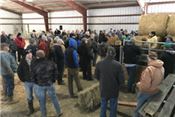|
Extension Hay Auctions Help Producers Find Much Needed Hay

Producers bid on hay during the 2019 Tri-County Hay and Straw Auction in Metcalfe County.
Photo by Kevin Lyons, Monroe County agriculture and natural resources extension agent.
LEXINGTON, KY.
In a year where hay supplies are tight, hay auctions hosted by the University of Kentucky Cooperative Extension Service have provided an important link for producers wanting to buy forages.
Supplies are limited because of the excessive rainfall the state received during the past year. Producers faced wet conditions at all stages of hay production. They cut hay late, or they harvested it on time, but it was rained on before they could package it. The abundant rainfall during this winter is also increasing the energy requirements of livestock, and to compensate, they are consuming more hay than usual.
“We are having a huge hay shortage,” said Brandon Bell, Metcalfe County extension agent for agriculture and natural resources. “Our producers were running out of hay in mid-January where normally they would start running low in mid-March.”
Bell, Chris Schalk and Kevin Lyons, who are agriculture and natural resources extension agents in Barren and Monroe counties, organize the Tri-County Hay and Straw Auction along with the Metcalfe County Fair Board. While the auction has occurred for several years, producers came from across the region and Middle Tennessee to purchase hay this year.
Brandon Sears, Madison County extension agent for agriculture and natural resources, has hosted a similar hay auction with his local fair board since 2008. He said producers typically come to the Madison County auction from about 50 to 60 miles away, but interest was definitely up this year.
Hay at both auctions sold for nearly double the price of a typical year. In Madison County, buyers purchased small square bales of alfalfa/orchardgrass for around $11 each. Round, 5 feet by 5 feet grass hay bales sold between $42 and $75. In Metcalfe County, small square bales of alfalfa went for $7 on average, and depending upon where they were stored, grass rolls went for around $40 for outside storage to $57.50 for inside storage.
In fact, the agents had trouble finding hay to sell and heavily relied on their connections with local producers to make it happen.
“It really showed me how little hay there was in the region,” Sears said. “A lot of our normal consigners were out when I asked them about selling hay this year.”
Customers received an added bonus when Kim Fields from the Kentucky Department of Agriculture brought the department’s mobile hay testing lab to both locations to test samples from each lot. Agents weighed the hay upon arrival. Before the auctions started, the agents provide a quick educational session on hay quality, the importance of hay testing, understanding the test results and how to supplement the hay to create feed rations that would give the livestock the nutrition they need.
“Farmers are really in a tough spot this year, and we want to help them not only purchase hay but make informed purchasing decisions,” Sears said. ∆
|
|